After years of owning what is considered a standard-size laptop (14.1" Compaq V1000), I decided to replace it and upgrade to something smaller, lighter, with better battery life and about the same power. So clearly a netbook was the solution to my problem.
I'm reviewing the Asus Eee PC 1000 - not to be confused with the 1000H, 1000HD, 1000HA or the 1000HE (for a full list of differences, check out Asus' comparison chart). The biggest difference between the Eee PC 1000 and its sister models is that this is the only model that features a solid state drive and an estimated six hours of battery life.
Here are the full specs:
- 40GB of flash memory
- 10.0" WSVGA LED backlit wide screen (1024x600)
- 1.3MP built-in webcam
- 1.8gHz Intel Atom N270 processor
- Integrated video card
- 1GB of DDR2 RAM
- 802.11b/g/n and Bluetooth antenna
- 10/100 Ethernet port
- 3 USB 2.0 ports
- VGA port
- built-in SD card reader
- built-in microphone and headphone jacks
- available in "˜pearl white' and "˜fine ebony'
Box Stuffers
Before we dive in to the meaty part of this review, lets first take a look the "box stuffers", which many times go overlooked, but don't worry... I won't spend too much time on this. If you have no interest in these, I suggest you just skip over this section.
So aside from the main unit, the box also includes a really nice laptop sleeve, a cleaning cloth, a 12v AC adapter, a pair of restore DVD's and a few manuals "" no big surprise here.
The "Quick Use Guide" lists out how to performs tasks that many may find simple and unnecessary "" such as how to insert the battery and power on the machine. It also shows briefly how navigate the default OS (a costume version of Xandros) as well as how to setup a network connection. Both the Hardware User's Manual and Software User's Manual cover the same topics the Quick Use Guide does but in further depth.
The box also comes with two recovery discs (Linux Recovery DVD and XP Support CD). I got a chuckle out of this, since the Eee PC 1000 is only available with Linux pre-installed (but the software manual details out how to install XP). These discs, as their name implies, are to restore your netbook back to factory settings. The "XP Support CD" does not install Windows XP on the machine, but is meant to be used on an existing Windows machine. It basically contains more documentation and a few support/diagnostic tools. In order to restore the default OS back to its default state, you also need to XP support CD. The disc has a utility that will format a (large than 2 GB) thumbdrive them prompt you to switch to the "Linux Recovery DVD" so it can make a bootable image of the DVD on the thumbdrive. Alternatively, you can plug in an external disc drive to the netbook and just boot off the "Linux Recovery DVD". Interestingly enough... there is no "Mac Support CD", so your restore options may be limited if you are a Mac user.
Lastly, it comes with a really nice black 10" laptop sleeve which is discreetly branded with the 'Eee' logo on it. The sleeve does not provide a lot of padding, but is perfect to protect the device when putting it in a bag with other objects. It is also made out of a really nice material and just feels great to the touch. I felt like this was a really nice added bonus.
But enough of the little things... let's get in to what all of you are here for "" a closer look at the Eee PC 1000.
Eee PC 1000
The unit I will be reviewing is a 10" 'Shine Black' Asus Eee PC 1000. While many people (myself included) feel that 10" is too big for the netbook category, I must say that I now feel different about that subject. I have used many 7" and 8" netbooks and found the keyboard impossible to use since the keys and screen real-estate were simply too small. But with this 10" model, the keyboard is only 5% smaller than a standard keyboard (without measuring the keypad) and makes such a small form-factor laptop a lot more functional. It also comes with three USB ports (two on the left, one on the right), a headphone and microphone jack, Ethernet port (base 100), VGA port and a SD card reader.
The Eee PC 1000 is advertised to have a 40GB solid state drive, but the truth is that is has two drives "" one 8GB and one 32GB. I find this pretty nice, since it allows you to install more than one OS without the need to re-partition or (as I did) you can use the 8 GB for /boot and / and put /home on the 32 GB (latter I'll explain why this is a good idea). I am not sure why they chose to do the 40GB in this manner, but I am rather happy they did.
Equipped with an Intel Atom n270 and a 6-cell battery, I've gotten up to 6.5 hours of battery life (with the screen set to mid brightness and wifi on) which is more than enough for a full out-of-the-office workday in my opinion. The default Xandros OS has an option to set the performance according what it determines necessary. What it actually does is under-clocks the CPU and adjusts the brightness according to the chosen option. I'm currently running Easy Peasy (formally Ubuntu-eee) on this unit, and the average battery life seems to have dropped to 5.5 to 6 hours on average, which is barely lower than what it's rated. This leads me to believe that the CPU does not automatically under-clock itself and relies on the OS to do so (but I could be wrong).
As to be expected, the object that adds the most weight is the battery. Removing the battery, the netbook is definitely below the 2lbs line (I'll even dear to say 1.5lb). But even with the increased weight of the 6-cell battery, it is lighter than a 550 page Linear Algebra book - meaning the weight it adds to my bag is negligible. It's small size (10.5" x 7.5" x 1.25") in combination with it's sub-3lbs makes it ideal for one-handed carrying, which is useful when you're moving around a lot or just need to re-adjust yourself on the sofa - and with 6 hours of battery lif"¦ you may be on that sofa for a long time.
As I mentioned earlier, this netbook has an 8gb and 32gb SSD and 1gb of RAM. These components are surprisingly easy to upgrade. The 32gb SSD and RAM are exposed by simply removing the bottom plate, but you will need to crack up the unit in order to access the 8gb module. But this makes sense, since the 8gb SSD is substantially faster than the 32gb module in this netbook - this is why I would recommend putting /boot on the 8gb - so Asus must have made the assumption that the faster device would not need to be upgraded. The maximum amount of RAM supported by the motherboard is 2gb of DD42-667 and the 32gb SSD can be replaced with any PCIe drive.
Moving back to the aesthetics of this unit, it features a glossy/reflective finish similar to the PlayStation 3 (in either black or white) which makes this netbook look very elegant to who ever sees it. The drawback of this elegance is that it's really good at picking up fingerprints and dust which could be a great annoyance for many. Luckily, it's easy to clean and doesn't scratch easily "" so taking a napkin to it solves the problem.
The featured keyboard is very comfortable and quiet. It's advertised as being 95% the size of a standard keyboard, which translate into no more two-finger typing or holding your hands closely when typing - it also means more comfort for those of us who have hands larger than a 10-year old.
While the keyboard is nice, it's not perfect. I have been using the eeePC 1000 for about three weeks at this point and my biggest complaint is the right-hand shift key. For some reason, they decided to make it the size of a normal letter key and put it behind the up-arrow key. This makes it very difficult to strike, causing the typer to hit the up-arrow in place of shift which results in switching up a line generating crazy typos.
Lastly, Asus added a few bells and whistles to the eeePC 1000 in the form for quick-keys, a 1.3MP webcam, a microphone array and status lights"" all which are very welcomed. There are a total of four quick-keys: two pre-set and two user programmable. The pre-set keys are used to turn off the display while the unit is still open and to quickly change the resolution. The webcam actually produces a decent picture for a 1.3MP cam, and coupled with the built-in mic array (or dual microphone if you may) it makes using your favorite video conference program or recording a quick video quick and painless. The status lights show the power state, battery level, hard drive IO and wireless status "" all on the front panel.
In conclusion, this is a fantastic netbook for $399. It offers a great balance between performance, battery life and portability at an affordable price. The fact that it actually has two SSDs was a nice surprise, the larger screen and keyboard makes things much more comfortable than a 7" or 8" netbook and the ability to replace the 32gb SSD with a larger module is also a big plus.
On the down side, the right shift key does get annoying from time to time, and the glossy finish is really good at making friends with fingerprints. Also, having a way to turn off the touch pad when typing would have been nice, since my thumb tends to tap the touch pad when typing for an extensive amount f time (such as writing this review) causing my curser to jump around the document.
Looking ahead into the future, the new Asus eeePC 1000HE (which was recently released) improves on a the keyboard, by fixing the right shift key, and is rated with a 9.5 hour battery life since it uses the new Atom N280; but this unit is only available with a normal hard drive - no solid state offered (yet?) - for the same price as the eeePC 1000.
![]() Link: More pictures
Link: More pictures![]() Link: hi-res picture
Link: hi-res picture
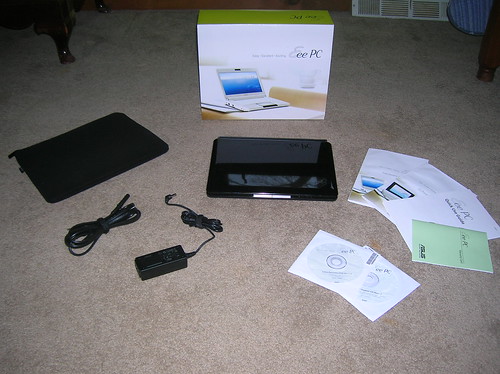
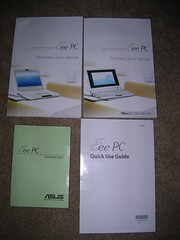
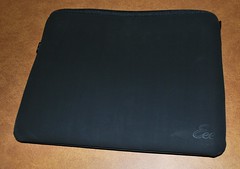
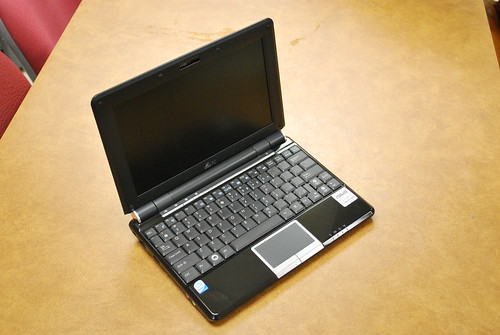

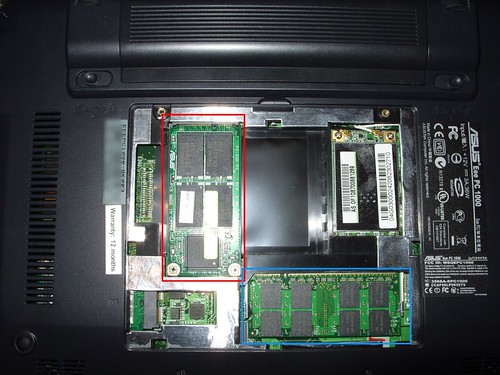
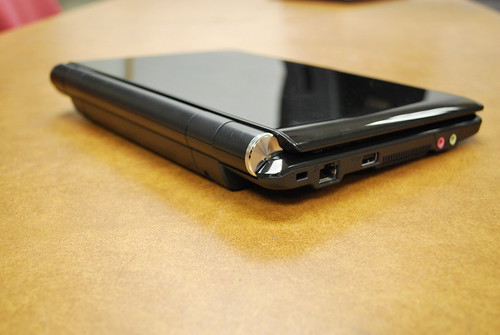
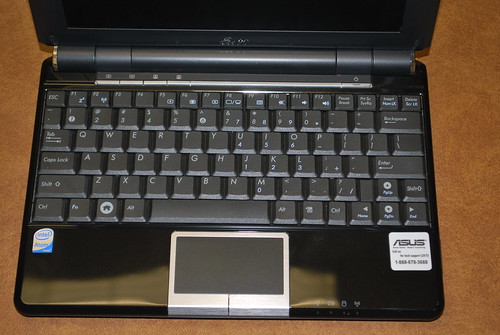
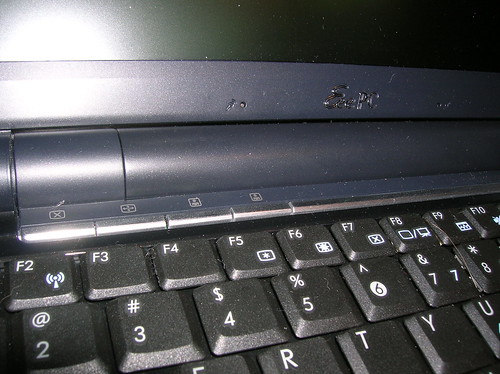
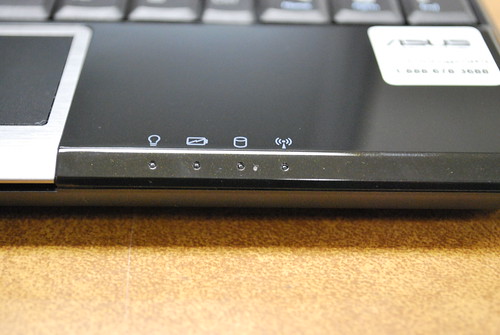














17 Comments - Add comment